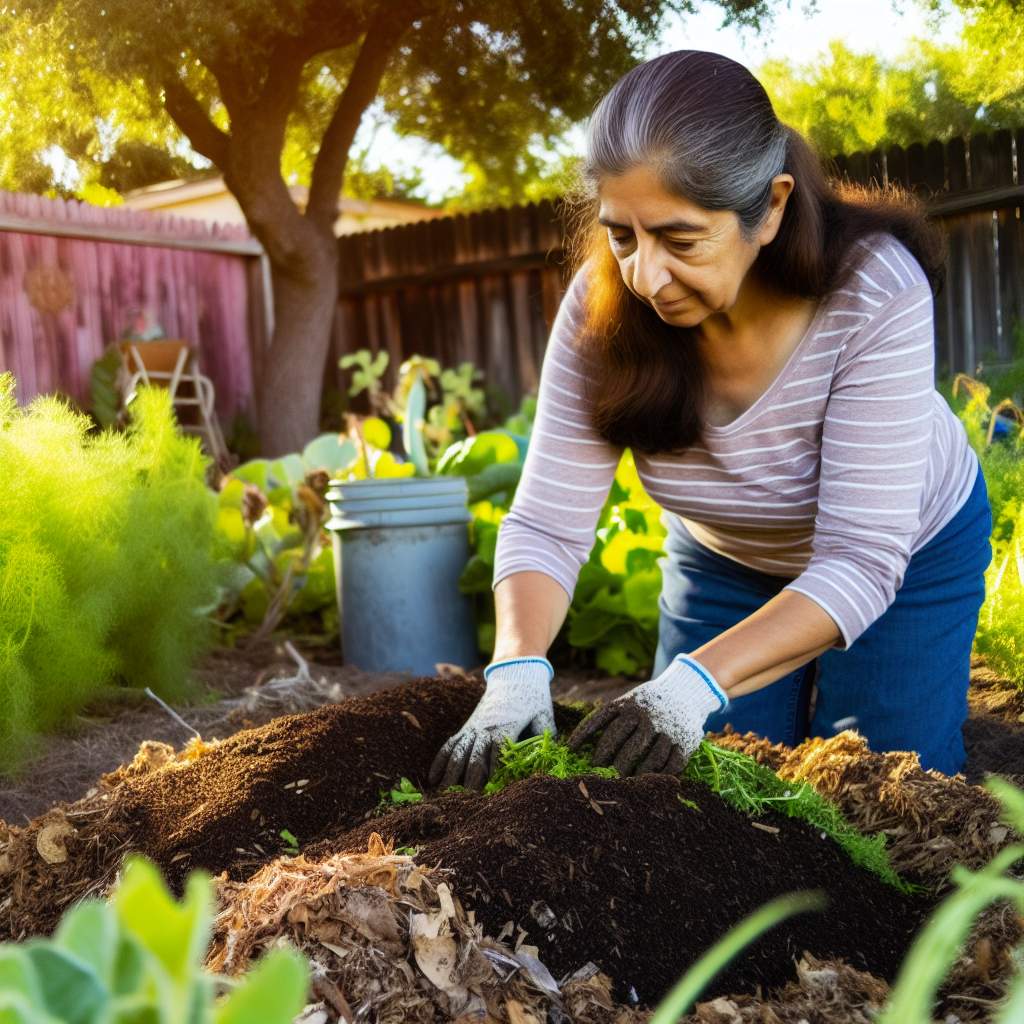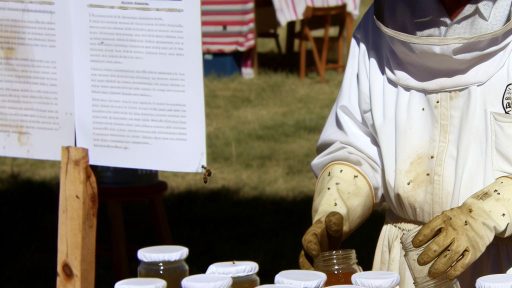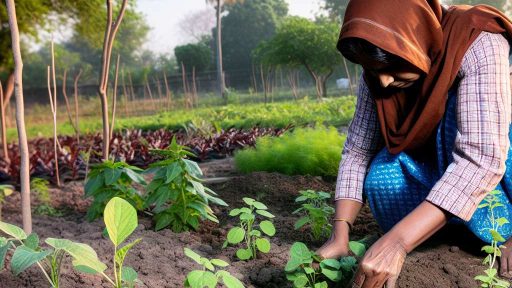Introduction to Soil Health
The Importance of Soil Health
Soil health is crucial for successful gardening.
It directly impacts plant growth and productivity.
Healthy soil supports a diverse ecosystem.
Additionally, it enhances nutrient availability.
Furthermore, it improves water retention in the soil.
Benefits for Gardeners
Understanding soil health offers numerous advantages to gardeners.
Healthy soil can reduce the need for chemical fertilizers.
This leads to safer and more organic gardening practices.
Moreover, it minimizes pest problems naturally.
As a result, plants become more resilient to diseases.
Economic Advantages
Investing in soil health can lead to cost savings.
Healthy soil often results in higher crop yields.
This increases potential profits for gardeners.
Additionally, it reduces long-term maintenance costs.
Consequently, improving soil health makes gardening sustainable.
Transform Your Agribusiness
Unlock your farm's potential with expert advice tailored to your needs. Get actionable steps that drive real results.
Get StartedLong-Term Sustainability
Promoting soil health contributes to environmental sustainability.
It aids in conserving biodiversity and natural habitats.
Healthy soils also play a role in carbon sequestration.
This helps in combating climate change effectively.
Overall, prioritizing soil health is essential for future generations.
Understanding Soil Composition: Key Elements and Their Roles
Essential Nutrients in Soil
Soy contains essential nutrients that support plant growth.
These nutrients include nitrogen, phosphorus, and potassium.
Nitrogen helps in leaf growth and vigor.
Phosphorus promotes root development and flowering.
Potassium plays a vital role in overall plant health.
Organic Matter’s Contribution
Organic matter enhances soil structure and fertility.
It boosts microbial activity, enriching soil life.
Additionally, organic matter improves water retention in soil.
This retention helps plants during dry periods.
The Role of pH Level
Soil pH affects nutrient availability to plants.
Most plants thrive in slightly acidic to neutral pH levels.
Regular soil testing can indicate necessary amendments.
Adjusting soil pH ensures optimal plant growth conditions.
Soil Texture Matters
Soil texture influences water retention and aeration.
Sandy soils drain quickly, while clay soils hold moisture.
Loamy soils provide an ideal balance for most plants.
Understanding your soil texture allows for better management.
Beneficial Soil Organisms
Various organisms contribute to soil health and fertility.
Earthworms aerate the soil and enhance nutrient cycling.
Showcase Your Farming Business
Publish your professional farming services profile on our blog for a one-time fee of $200 and reach a dedicated audience of farmers and agribusiness owners.
Publish Your ProfileBacteria and fungi break down organic matter effectively.
This decomposition process releases essential nutrients for plants.
Composting for Soil Health
Composting recycles organic waste back into the soil.
This practice enriches soil with valuable nutrients.
Moreover, compost improves soil structure and moisture retention.
Regular use of compost supports long-term soil health.
DIY Compost Bins: How to Create Your Own Nutrient-Rich Compost
Understanding the Importance of Compost
Compost enriches soil, improving fertility and structure.
It enhances the soil’s ability to retain moisture, benefiting plants.
Furthermore, compost reduces the need for chemical fertilizers.
Using compost promotes sustainable gardening practices.
Choosing the Right Location
Select a spot that is convenient for access and maintenance.
Ensure the location receives adequate air circulation and sunlight.
A shaded area can help maintain moisture in hot climates.
Gathering Materials for Your Compost Bin
Recycled wood pallets make excellent compost bin walls.
Wire mesh can also be used for a breathable structure.
Consider using a plastic bin if you’re short on space.
Be sure to include a variety of organic materials for effective composting.
Constructing Your Compost Bin
Begin by assembling your chosen materials into a rectangular shape.
Secure the corners with nails or screws for stability.
Include a lid to keep pests out and retain moisture.
Layering Your Compost Materials
Start with a base of coarse materials like twigs or straw.
Add a mix of green materials, such as vegetable scraps.
Include brown materials, like dried leaves and paper, for balance.
Layering helps create the right environment for decomposition.
Maintaining Your Compost Bin
Turn the compost weekly to aerate and speed up the process.
Keep the compost moist, but not soggy, for best results.
If it smells, add more brown materials to improve odor.
Using Your Finished Compost
Once finished, your compost will be dark and crumbly.
Use it to enhance garden beds or potted plants.
Spread it as a top dressing for lawns to enrich soil.
By using compost, you contribute to a healthier garden ecosystem.
Find Out More: How to Protect Bee Colonies From Pests and Diseases in the USA
Cover Crops: Selecting and Planting for Soil Enrichment
Why Cover Crops Matter
Cover crops play a crucial role in improving soil health.
They prevent soil erosion during idle times.
Moreover, they enhance organic matter and nutrient content.
Using cover crops can also suppress weeds effectively.
Types of Cover Crops
Various types of cover crops exist for different needs.
- Legumes, such as clover and vetch, fix nitrogen.
- Grasses like rye and oats provide biomass and prevent erosion.
- Brassicas, including turnips and radishes, improve soil structure.
Selecting the Right Cover Crop
Choosing the right cover crop depends on your soil and climate.
Consider your primary goals for soil enrichment.
Also, evaluate the time of year you plan to plant them.
Showcase Your Farming Business
Publish your professional farming services profile on our blog for a one-time fee of $200 and reach a dedicated audience of farmers and agribusiness owners.
Publish Your ProfileConsult local agricultural resources for specific recommendations.
Planting Cover Crops
Once you choose a cover crop, prepare your soil.
Clear debris and loosen the top layer to facilitate growth.
Follow the seed packet instructions for proper planting depth.
Ensure consistent watering until the seedlings establish.
Managing Your Cover Crops
Monitor growth regularly to assess their health and development.
Consider terminating cover crops before planting cash crops.
Use methods like mowing or crimping for effective termination.
This practice allows you to incorporate plant matter back into the soil.
Benefits Beyond Soil Health
Cover crops provide numerous ecological benefits.
They attract beneficial insects and pollinators.
Additionally, they reduce compaction in the soil.
Using cover crops fosters a sustainable farming environment.
Delve into the Subject: Indoor Gardening Ideas for Utilizing Vertical Farming in Small Areas
Building Raised Garden Beds
Benefits for Soil Aeration
Raised garden beds significantly improve soil aeration.
These beds elevate the soil above ground level.
As a result, air can circulate more freely through the soil.
This enhanced aeration supports healthy root development.
Consequently, plants can access oxygen more efficiently.
Moreover, well-aerated soil promotes beneficial microbial activity.
This activity can improve overall soil structure.
Improved Drainage
Building raised garden beds enhances drainage capabilities.
Excess water can easily flow away from the roots.
This helps prevent waterlogging and root rot.
Additionally, raised beds warm up more quickly in spring.
Thus, they extend the growing season for plants.
Furthermore, these beds can allow for better management of soil moisture.
Creating the Perfect Raised Bed
Start by choosing a suitable location for the bed.
Select a spot that receives sufficient sunlight throughout the day.
Next, determine the dimensions of your raised bed.
Typical dimensions range from 4 feet wide to 6 inches deep.
Consider using rot-resistant materials such as cedar or composite wood.
Finally, fill your raised bed with quality soil and compost.
This combination ensures your plants receive essential nutrients.
Delve into the Subject: How to Choose the Right Seeds for High-Yield Microgreens Farming
Creating Mulch
Types of Mulch
Mulch comes in various forms, each serving unique purposes.
Organic mulch comprises materials like wood chips, straw, and leaves.
These materials decompose over time, enriching the soil.
In contrast, inorganic mulch includes stones, plastic, and rubber.
These types do not decompose, providing long-lasting coverage.
Showcase Your Farming Business
Publish your professional farming services profile on our blog for a one-time fee of $200 and reach a dedicated audience of farmers and agribusiness owners.
Publish Your ProfileImpact on Soil Moisture
One major benefit of mulch is its ability to retain soil moisture.
Organic mulch absorbs water, then slowly releases it to the soil.
This process helps plants access water during dry spells.
On the other hand, inorganic mulch prevents evaporation effectively.
It protects soil from the sun, keeping moisture levels stable.
Impact on Soil Temperature
Mulch significantly affects soil temperature, benefiting plant health.
During hot seasons, it insulates the soil, keeping it cool.
Conversely, in colder months, mulch helps retain warmth.
This temperature regulation promotes root growth and vitality.
As a result, mulched plants show improved resilience and productivity.
Delve into the Subject: Seasonal Gardening for Drought-Resistant Crops

Worm Composting
Setting Up a Vermicomposting System
Create an inviting environment for worms to thrive.
Begin by selecting a suitable container for your vermicomposting system.
Common choices include plastic bins or wooden boxes.
Ensure the container has proper drainage holes.
Feed your worms with organic waste like fruit peels and vegetable scraps.
Remember to balance green and brown materials for optimal results.
Use shredded paper or cardboard to create a bedding layer.
This layer keeps the worms moist and comfortable.
Place your container in a dark, cool area to maintain an ideal temperature.
Avoid direct sunlight to prevent overheating.
Regularly monitor the moisture level in the container.
The bedding should feel damp but not soggy.
Once the worms have processed the food, they will produce nutrient-rich castings.
You can harvest worm castings every few months.
Simply separate the worms from the castings using light exposure.
Apply the finished compost to your garden beds.
This will enhance soil structure and enrich nutrient content.
Your plants will thrive with this natural fertilizer.
Benefits of Vermicomposting
Vermicomposting contributes to healthier soil and increased plant growth.
It helps reduce landfill waste by recycling kitchen scraps.
Moreover, it provides a sustainable solution to soil amendment.
Worm castings are rich in nutrients like nitrogen, phosphorus, and potassium.
Additionally, they improve soil aeration and moisture retention.
Furthermore, this practice encourages beneficial microbial activity in the soil.
Vermicomposting requires minimal space, making it perfect for any garden.
Ultimately, it’s an eco-friendly way to enhance garden health.
Soil Testing DIY: How to Test and Amend Your Soil for Optimal Growth
Understanding Soil Health
Soil health is critical for successful gardening.
Healthy soil promotes robust plant growth and increases yield.
To start, we need to know the condition of our soil.
Showcase Your Farming Business
Publish your professional farming services profile on our blog for a one-time fee of $200 and reach a dedicated audience of farmers and agribusiness owners.
Publish Your ProfileTesting Your Soil
Testing your soil provides valuable insights.
You can perform soil tests using simple DIY methods.
First, collect soil samples from different areas of your garden.
Make sure to take samples from a depth of about six inches.
Next, allow the soil samples to dry before processing.
Consider using a soil test kit for accurate results.
These kits typically measure pH and nutrient levels.
Understanding Test Results
After testing, review the results carefully.
Focus on pH, nitrogen, phosphorus, and potassium levels.
The ideal pH for most plants is around 6.0 to 7.0.
Additionally, check for deficiencies or toxicities in minerals.
Identify any amendments needed based on these readings.
Amending Your Soil
Once you have your test results, it’s time to amend your soil.
Start by adjusting the pH if necessary.
You can add lime to raise the pH or sulfur to lower it.
Next, incorporate organic matter for improved nutrient levels.
Compost is an excellent choice for enriching soil.
Also, consider adding fertilizers based on your test results.
Regular Monitoring
Soil health requires ongoing attention and testing.
Plan to test your soil every few years.
This helps you track improvements and adjust your amendments.
Remember, a healthy garden starts with healthy soil.
Permaculture Techniques
Utilizing Natural Resources
Permaculture emphasizes the use of natural resources to improve soil health.
It encourages the integration of plants, animals, and ecosystems.
Start by observing your garden’s natural systems.
Identify patterns that could enhance soil structure and fertility.
Cover Cropping
Cover cropping protects soil during off-seasons.
It prevents erosion and improves organic matter content.
Plants like clover and rye serve as effective cover crops.
Mixing these crops boosts biodiversity in the garden.
Composting
Creating a compost pile enriches soil with nutrients.
Use kitchen scraps, yard waste, and coffee grounds.
Regularly turn the compost to facilitate decomposition.
After a few months, your compost will be ready to use.
Crop Rotation
Crop rotation helps maintain soil fertility and prevent pests.
By changing plant families each season, you promote nutrient balance.
This practice disrupts pest and disease cycles.
Plan your crop rotation with careful consideration.
Mulching
Mulching conserves moisture and suppresses weeds in your garden.
Organic materials like straw or wood chips work effectively.
Showcase Your Farming Business
Publish your professional farming services profile on our blog for a one-time fee of $200 and reach a dedicated audience of farmers and agribusiness owners.
Publish Your ProfileApply mulch after planting to protect young seedlings.
This method also enhances soil structure as it decomposes.
Integrating Livestock
Integrating livestock into your garden benefits soil health.
Chickens, for example, can help with pest control.
They naturally fertilize the soil with their waste.
Ensure you manage their movement to prevent overgrazing.
Creating Swales
Swales are trenches on contour that capture rainwater.
They reduce erosion and promote water infiltration in soil.
Planting vegetation along swales further enhances their benefits.
Use swales to create a self-sustaining ecosystem.
Additional Resources
Korean Natural Farming Basics – Mother Earth Gardener
The regenerative urban garden I: No-till gardening — make gather …




